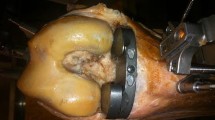Abstract
Purpose
Clinical outcome of TKA remains unsatisfactory in 20% of the cases. Navigation has added accuracy in terms of alignment, but has improved clinical outcome only in small series with gap-balanced techniques. Reason for that could be that conventional gap balanced TKA determines gaps in extension and 90° of flexion only. Furthermore, measurement is only static. Therefore, the accuracy of a new dynamic navigation software which allows gap assessment throughout the entire range of motion was tested. The purpose of this study was to investigate the accuracy and reliability of dynamic gap testing during gap-balanced TKA.
Methods
In two different centres, a total of 65 TKA procedures were performed in a tibia-first, gap-balanced technique using a new CAS software. At the same and at different time points of surgery, two different surgeons performed gap measurement to provide inter-observer reliability data and repeated gap measurement to provide intra-observer reliability data. These gap measurements were performed throughout the entire ROM under dynamic stress testing to detect maximum gap values.
Results
CAS surgery was able to produce correct coronal alignment in 96.4% of the cases (within 3° mechanical alignment). Both inter-observer and intra-observer reliabilities were excellent for gap values throughout the entire ROM. Inter-observer bias of deviation 0.05; 95% limits of agreement of − 2.1 to + 2.21 mm. Intra-observer bias of deviation 0.09; 95% limits of agreement of − 2.27 to + 2.44 mm.
Conclusions
This new CAS software in combination with the presented dynamic gap measurement provides accurate gap values and therefore facilitates balancing TKA. This technique works reproducibly for different surgeons and has proven robustness also for repeated measurements of any surgeon in this study.







Similar content being viewed by others
References
Castelli CC, Falvo DA, Iapicca ML et al (2016) Rotational alignment of the femoral component in total knee arthroplasty. Ann Transl Med 4(1):4
Daines BK, Dennis DA (2014) Gap balancing vs. measured resection technique in total knee arthroplasty. Clin Orthop Surg 6(1):1–8
Griffin FM, Insall JN, Scuderi GR (2000) Accuracy of soft tissue balancing in total knee arthroplasty. J Arthroplast 15(8):970–973
Hino K, Kutsuna T, Watamori K et al (2017) Varus-valgus stability at 90° flexion correlates with the stability at midflexion range more widely than that at 0° extension in posterior-stabilized total knee arthroplasty. Arch Orthop Trauma Surg 137(10):1429–1434
Hutt JRB, LeBlanc M-A, Massé V et al (2016) Kinematic TKA using navigation: surgical technique and initial results. Orthop Traumatol Surg Res 102(1):99–104
Jiang J, Kang X, Lin Q et al (2015) Accuracy of patient-specific instrumentation compared with conventional instrumentation in total knee arthroplasty. Orthopedics 38(4):305–313
Lehnen K, Giesinger K, Warschkow R et al (2011) Clinical outcome using a ligament referencing technique in CAS versus conventional technique. Knee Surg Sports Traumatol Arthrosc 19(6):887–892
Mason JB, Fehring TK, Estok R et al (2007) Meta-analysis of alignment outcomes in computer-assisted total knee arthroplasty surgery. J Arthroplast 22(8):1097–1106
McClelland JA, Webster KE, Ramteke AA, Feller JA (2017) Total knee arthroplasty with computer-assisted navigation more closely replicates normal knee biomechanics than conventional surgery. Knee 24(3):651–656
Mihalko WM, Saleh KJ, Krackow KA et al (2009) Soft-tissue balancing during total knee arthroplasty in the varus knee. J Am Acad Orthop Surg 17(12):766–774
Mullaji AB, Shetty GM (2016) Correcting deformity in total knee arthroplasty: techniques to avoid the release of collateral ligaments in severely deformed knees. Bone Joint J 98-B(1 Suppl A):101–104
Nowakowski AM, Majewski M, Müller-Gerbl M et al (2012) Measurement of knee joint gaps without bone resection: “physiologic” extension and flexion gaps in total knee arthroplasty are asymmetric and unequal and anterior and posterior cruciate ligament resections produce different gap changes. J Orthop Res 30(4):522–527
Ramappa M (2015) Midflexion instability in primary total knee replacement: a review. SICOT J 1:24
Sassoon A, Nam D, Nunley R et al (2015) Systematic review of patient-specific instrumentation in total knee arthroplasty: new but not improved. Clin Orthop Relat Res 473(1):151–158
Sharkey PF, Lichstein PM, Shen C et al (2014) Why are total knee arthroplasties failing today—has anything changed after 10 years? J Arthroplast 29(9):1774–1778
Victor J (2017) Optimising position and stability in total knee arthroplasty. EFORT Open Rev 2(5):215–220
Vince KG (2003) Why knees fail. J Arthroplast 18(3 Suppl 1):39–44
Whiteside LA, Kasselt MR, Haynes DW (1987) Varus-valgus and rotational stability in rotationally unconstrained total knee arthroplasty. Clin Orthop Relat Res 219:147–157
Wilson CJ, Theodoulou A, Damarell RA, Krishnan J (2017) Knee instability as the primary cause of failure following TotalKnee Arthroplasty (TKA). A systematic review on the patient, surgical and implant characteristics of revised TKA patients. Knee 24(6):1271–1281
Funding
The authors did not receive financial support for this research, authorship or publication.
Author information
Authors and Affiliations
Corresponding author
Ethics declarations
Conflict of interest
Dr. Graichen reports personal fees from Brainlab, personal fees from DePuy, outside the submitted work. Dr. Strauch reports personal fees from DePuy Johnson & Johnson, personal fees from Brainlab, outside the submitted work. The other authors have nothing to disclose.
Ethical approval
Ethical approval was granted by the responsible German and Spanish ethics committee.
Informed consent
Patients were informed and they consented to conduct the study.
Rights and permissions
About this article
Cite this article
Mehliß, V., Strauch Leira, M., Serrano Olaizola, A. et al. Proven accuracy for a new dynamic gap measurement in navigated TKA. Knee Surg Sports Traumatol Arthrosc 27, 1189–1195 (2019). https://doi.org/10.1007/s00167-018-4989-0
Received:
Accepted:
Published:
Issue Date:
DOI: https://doi.org/10.1007/s00167-018-4989-0




